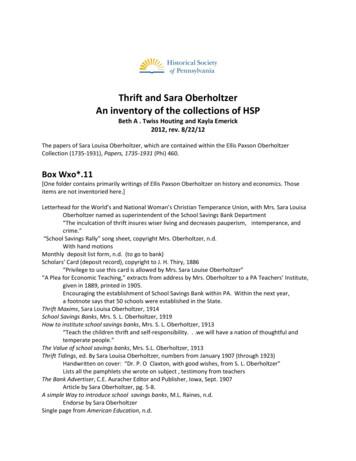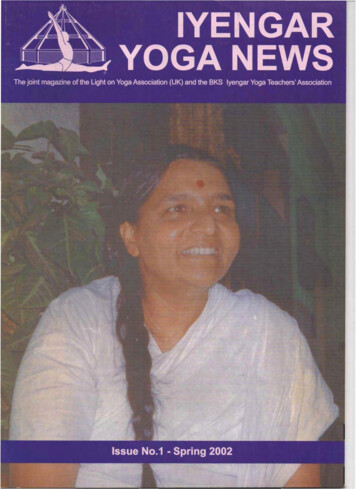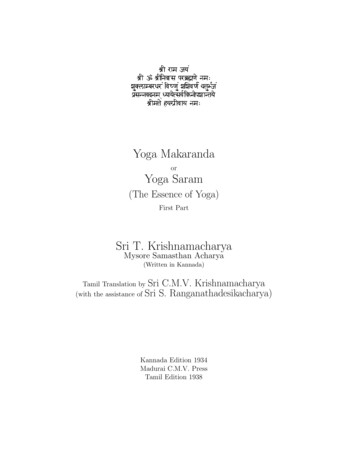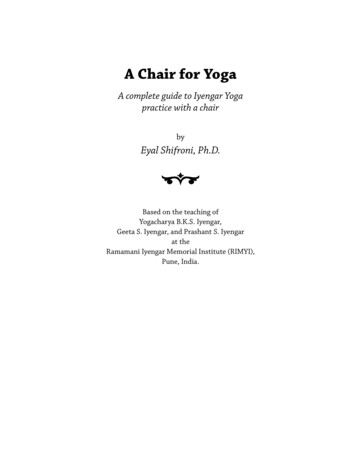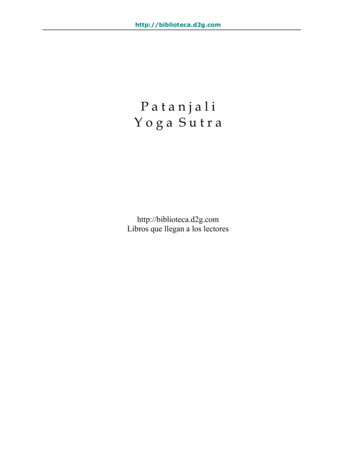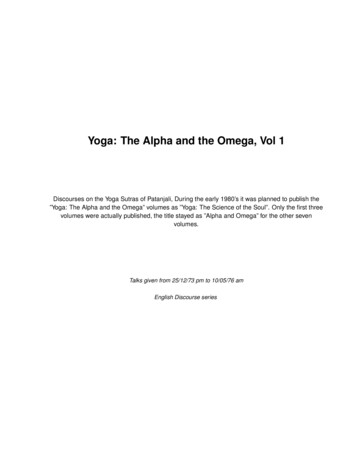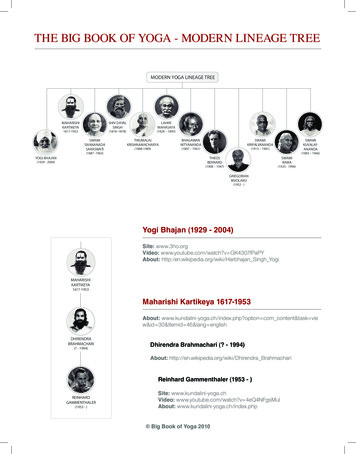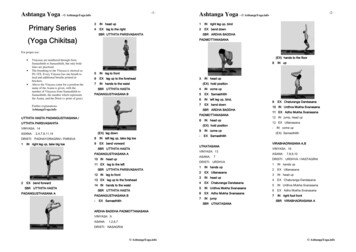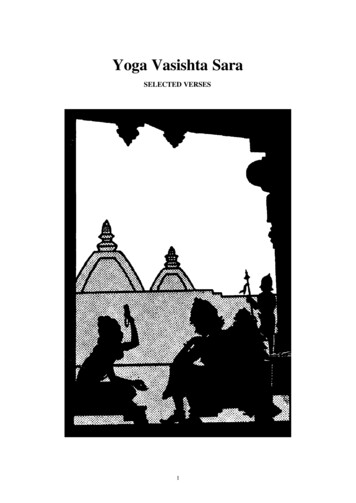
Transcription
Yoga Vasishta SaraSELECTED VERSES1
Yoga Vasishta Sara(THE ESSENCE OF YOGA YASISHTA)An English Translation from the Sanskrit OriginalPublisherY S. RAMANANPresident, Board of Trustees,Sri Ramanasramam,Tiruvannamalai-606 603.S. India.19992
OM SRI GANESAYA NAMAHPREFACEThis English version of the Yoga Vasishta Sara is based on a translation made by SwamiSureshananda, an old devotee of Bhagavan, who has founded an asramam named Vijna naRamaneeyam at Palghat and has translated several works of Bhagavan as well as the YogaVasishta Sara into Malayalam. This was published serially in The Mountain Path, the journalpublished by Sri Ramanasramam, during 1969 to 1971 and is now issued in the form of a bookfor facility of reference.Sri Ramanasramam15th July, 1973Guru-Poornima.President, Board of Trustees3
INTRODUCTIONThe Brihat (the Great) Yoga Vasishta or Yoga Vasishta Maha Ramayana as it is also called, is awork of about 32,000 Sanskrit couplets, traditionally attributed to Valmiki, the author of SrimadRamayana. It is a dialogue between Sage Vasishta and Sri Rama, during which Advaita (thedoctrine of nonduality) in its pure form of ajatavada (theory of non-origination) is expounded,with illustrative stories in between. This vast work was abridged some centuries ago byAbhinanda Pandita, a Kashmiri scholar, into 6,000 couplets, which go by the name of LaghuYoga Vasishta. This is a masterpiece in itself, like the original Brihat.Bhagavan Sri Ramana Maharshi used to refer to Yoga Vasishta frequently and has evenincorporated six couplets from it in His Supplement to Forty Verses (verses 21 to 27).A further condensation of this work was made long ago, by an unknown author, into about 230couplets, divided into ten. chapters, as Yoga Vasishta Sara (Essence of Yoga Vasishta ), of whichthis translation is presented for the first time. By making this condensation the author hasrendered a great service to all sadhaks. This is indeed a gold mine fit for repeated reading andmeditation.PUBLISHERNote: An English translation of the Brihat Yoga Vasishta by Vihari Lal Mitra is out of print.Translation of Laghu Yoga Vasishta by K. Narayanaswamy lyer is available from theTheosophical Publishing House, Madras-2o.4
CONTENTSCHAPTERPAGE1. DISPASSION.62. REALITY OF THE WORLD.83. THE MARKS OF A LIBERATED PERSON.114. DISSOLUTION OF THE MIND.135. THE DESTRUCTION OF LATENT IMPRESSIONS.156. MEDITATION ON THE SELF.177. METHOD OF PURIFICATION.188. WORSHIP OF THE SELF.209. EXPOSITION OF THE SELF.2110. NIRVANA.245
YOGA VASISHTA SARACHAPTER ONEDISPASSION1. Salutations to that calm effulgence which, is endless and unlimited by space,time etc., the pure consciousness which can be known by experience only.2. Neither one who is totally ignorant nor one who knows it (i.e. Truth) is eligible to study thisbook. Only he who thinks' I am bound ; I must become free ' is entitled to study it.3. Until one is definitely blessed by the Supreme Lord he will not find either a proper Guru orthe right scripture.4. Just as a steady boat, O Rama, is obtained from a boatman, so also the method of crossing theocean of samsara is learnt by associating with great souls.5. The great remedy for the longlasting disease of samsara is the enquiry, 'Who am I ?, to whomdoes this samsara belong ?, ' which entirely cures it.6. Not a day should be spent in a place which does not possess the tree of a wise knower of Truthwith its good fruit and cool shade.7. The sages are to be approached even if they do not teach. Even their talks in a light veincontain wisdom.8. The company of sages converts emptiness into fullness, death into immortality and adversityinto prosperity.9. If sages were concerned solely with their own happiness with whom could those tormented bythe sorrows of samsara seek refuge.?10. That which is imparted, O good soul, to a worthy disciple who has become dispassionate, isthe real wisdom; it is the real purport of the sacred texts and is also the comprehensive wisdom.11. Following the customary method of teaching is only for preserving the tradition. Pureawareness results solely from the clarity of the disciple's understanding.12. The Lord cannot be seen with the help of the sacred texts or the Garu. The self is seenby the Self alone with the pure intellect.13. All the arts acquired by men are lost by lack of practice, but this art of wisdom grows steadilyonce it rises.6
Yoga Vasishta SaraChapter One14. Just as an ornament worn round the neck is considered lost through forgetfulness and isgained when the mistake is realized, so also the Self is attained (when the delusion is removed)by the words of the Guru.15. He is indeed an unfortunate person who, not knowing his own Self, takes pleasure insense-objects, like one who realizes too late that-the food eaten by him was poisonous.16. That perverted man who, even after knowing that worldly objects are deceptive, still thinksof them, is an ass, not a man.17. Even the slightest thought immerses a man in sorrow ; when devoid of all thoughts he enjoysimperishable bliss.18. Just as we experience the delusion of hundreds of year in a dream lasting an hour, so also weexperience the sport of maya in our waking state.19. He is a happy man whose mind is inwardly cool and free from attachment and hatredand who looks upon this (world) like a mere spectator.20. He who has understood well how to abandon all ideas of acceptance and rejection and whohas realized the consciousness which is within the innermost heart - his life is illustrious.21. On the dissolution of the body the ether (consciousness) limited by the heart (hrdayam )alone ceases to Exist. People lament needlessly that the Self is extinct.22. When pots, etc. are broken the space within them becomes unlimited. So also when bodiescease to exist the Self remains eternal and unattached.23. Nothing whatever is born or dies anywhere at any time. It is Brahman aloneappearing illusorily in the form of the world.24. The Self is more extensive than space; it is pure, subtle, undecaying and auspicious. As suchhow could it be born and how can it die ?25. All this is the tranquil, One without beginning, middle or end, which cannot be said to beexistent or non-existent. Know this and be happy.26. O Rama, it is indeed nobler to wander begging about the streets of the outcasts (chandalas),an earthen bowl in, hand, than to live a life steeped in ignorance.27. Neither disease nor poison nor adversity nor any other thing in the world causes moresuffering to men than such stupidity engendered in their bodies.7
CHAPTER TWOUNREALITY OF THE WORLD1. Just as the great ocean of milk became still when the Mandara Mountain (with which it waschurned by the Devas and the Asuras) became still, even so the illusion of samsara comes to anend when the mind is stilled.2. Samsara rises when the mind becomes active and ceases when it is still. Still the mind,therefore, by controlling the breath and the latent desires (vasanas).3. This worthless ( lit. burnt out) samsara is born of one's imagination and vanishes in theabsence of imagination. It is certain that it is absolutely unsubstantial.4. The idea of a (live) snake in a picture of a snake ceases to be entertained when the truth isknown. Similarly samsara ceases to exist (when the Truth is realized), even if it continues toappear.5. This long- living ghost of a samsara which is the creation of the deluded mind of man and thecause of his sufferings disappears when one ponders over it.6. O Rama, maya is such that it brings delight through its own destruction ; its nature isinscrutable ; it ceases to exist even while it is being obs erved.7. Dear boy, wonderful indeed is this maya which deludes the entire world. It is on account of itthat the. Self is not perceived even though it pervades all the limbs of the body.8. Whatever is seen does not truly exist. It is like the mythical city of Gandharvas (fata morgana)or a mirage.9. That which is not seen, though within us, is called the eternal and indestructible Self.10. Just as the trees on the bank of a lake are reflected. in the water, so also all these variedobjects are reflected in the vast mirror of our consciousness.11. This creation, which is a mere play of consciousness, rises up, like the delusion of a snake ina rope (when there is ignorance) and comes to an end when there is right knowledge.12. Even though bondage does not really exist, it becomes strong through desire for worldlyenjoyments ; when this desire subsides bondage becomes weak.13. Like waves rising up from the ocean the unstable mind rises out of the vast and stableexpanse of the Supreme Self.14. It is because of that which always, of its own accord, imagines (everything) quickly andfreely that this magical show (of the world) is projected in the waking state.8
Yoga Vasishta SaraChapter Two15. This world, though unreal, appears to exist and is the cause of life- long suffering to anignorant person, just as a (non-existent) ghost (is the cause of fear) to a boy.16. One who has no idea of gold sees only the bracelet. He does not at all have the idea that it ismerely gold.17. Similarly towns, houses, mountains, serpents, etc. are all in the eyes of the ignorant man,separate objects. From the absolute point of view this objective (world) is the subject (the Self)itself ; it is not separate (from the Self).18. The world is full of misery to an ignorant man and full of bliss to a wise man. The world isdark to a blind man and bright to one who has eyes.19. The bliss of a man of discrimination, who has rejected samsara and discarded all mentalconcepts, constantly increases.20. Like clouds which suddenly appear in a clear sky and as suddenly dissolve the entireuniverse (appears) in the Self and (dissolves in it).21. He who reckons the rays as non-different from the sun and realizes that they are the sun itselfis stated to be nirvikalpa (the undifferentiating man).22. Just as the cloth, when investigated, is seen to be nothing but thread, so also this world, whenenquired into, is (seen to be) merely the Self.23. This fascinating world rises like a wave in the ambrosial ocean of conscio usness anddissolves in it. How then can it be different from it (i.e. consciousness) in the middle (i.e. when itappears) ?24. Just as the foam, the waves, the dew and the bubbles are not different from water, even sothis world which has come out of the Self is not different from the Self.25. Just as a tree consisting of fruits, leaves, creepers, flowers, branches, twigs and roots, existsin the seed of the tree, even so this manifest world exists in Brahman.26. Just as the pot (ultimately) goes back to mud, waves into water and ornaments into gold, soalso this world which has come out of the Self (ultimately) goes back to the Self.27. The snake appears when one does not recognize the rope; it disappears when one recognizesthe rope. Even so this world appears when the Self is not recognized ; it disappears when the Selfis recognized.9
Yoga Vasishta SaraChapter Two28. It is only our forgetfulness of the invisible Self which causes the world to appear just as (theignorance of the) rope (causes the) snake to appear.29. Just as the dream becomes unreal in the waking state and the waking state in the dream, soalso death becomes unreal in birth and birth in death.30. All these are thus neither real nor unreal. They are the effect of delusion, mere impressionarising out of some past experiences.10
CHAPTER THREETHE MARKS OF A LIBERATED PERSON( JIVAN MUKTA )1. The knowledge of the Self is the fire that burns up the dry grass of desire. This indeed is whatis called samadhi, not mere abstention from speech.2. He who realizes that the whole universe is really nothing but consciousness arid remainsquite calm is protected by the armour of Brahman; he is happy.3. The yogi who has attained the state which is beyond everything and remains always cool asthe full moon is truly the Supreme Lord.4. He who reflects in his innermost heart upon the purport of the Upanishads dealing withBrahman and is not moved by joy and sorrow, is not tormented by samsara.5. Just as birds and beasts do not take shelter on a mountain on fire, so also evil (thoughts) neveroccur to a knower of Brahman.6. Wise men also, like foolish men, (occasionally) make others angry, (but they do so only)in order to test their ability to control their innate feelings (that is to say to see how far theanger of other persons will affect them).7. Just as the trembling (of the body) caused by the (imaginary) snake persists (f of sometime) even after realizing that there is no snake, so also the effect of delusion persists (forsome time) even after getting rid of all delusions.8. Just as a crystal is not stained by what is reflected in it, so also a knower of truth is not reallyaffected by the result o his acts.9. Even while he is intent on outward actions (the knower of Truth) always remains introvertedand extremely calm like one asleep.10. Firmly convinced of non-duality and enjoying perfect mental peace, yogis go about theirwork seeing the world as if it were a dream.11. Let death come to him (the knower of truth) today or at the end of aeons; he remainsuntarnished like gold buried in mire.12. He may cast off his body at Kashi or in the house of an outcast ( lit. one who cooks dog'sflesh). He, the desireless one, is liberated at the very moment he attains knowledge (ofBrahman).13. To one who is desireless the earth, O Rama, is (as insignificant as) the hoof-print of a cow,Mount Meru a mound, space as much as contained in a casket and the three worlds a blade ofgrass.11
Yoga Vasishta SaraChapter Three14. Like an empty vessel in space (the knower of Truth) is empty both within and without, whileat the same time he is full within and without like a vessel immersed in the ocean.15. He who neither likes nor dislikes the objects seen by him and who acts (in the world) likeone asleep, is said to be a
The Brihat (the Great) Yoga Vasishta or Yoga Vasishta Maha Ramayana as it is also called, is a work of about 32,000 Sanskrit couplets, traditionally attributed to Valmiki, the author of Srimad Ramayana. It is a dialogue between Sage Vasishta and Sri Rama, during which Advaita (the doctrine of nonduality) in its pure form of ajatavada (theory of non-origination) is expounded, with illustrative .


